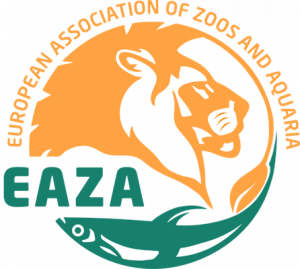
One of the most successful breeding pairs, coming from a captive background, hatched yet another chick in the wild in Andalucia! The Bearded Vulture captive breeding centre of Guadalentín in Andalucia also produced five Bearded Vulture chicks so far this season!
The first wild chick in Andalucia for 2020
Consejería de Agricultura, Ganadería, Pesca y Desarrollo Sostenible has confirmed the that the first wild Bearded Vulture chick hatched in Andalusia for 2020, which has been called Savuti and broke its shell at the beginning of March. The technicians of Plan de Recuperación de Aves Necrófagas de la Comunidad Autónoma and an agent of Medio Ambiente Comisionado made the historic discovery. They were also able to observe its parents feeding it, who come from a captive breeding background. Both parents are adults who hatched in Guadalentín – the female hatched in 2012 and the male in 2010. They were released within the framework of the reintroduction project of the Bearded Vulture in Andalusia, led by the Junta de Andalucía, following the extinction of the species in 1986.
A successful breeding pair
These birds have been successful in their breeding every year since 2017, so the chick that hatched in 2020 is already the fourth of this experienced pair that surprises technicians for its high efficiency. The Bearded Vulture can live for a long period of time, sometimes exceeding 40 years of life. This species has a very long reproductive cycle that begins during October and concludes around August or September with the fledgling of the youngling. It is, therefore, a demanding breeding process from the physical point of view, since it involves, among other activities, the defence of the territory, the construction of the nest, a period of copulations, the laying, the hatching and the search for food for the chick.
It is not very common for a pair to manage to breed successfully for four consecutive years. So the success of the Andalusian pair can also be contributed to their natural environment that is of high quality, with an abundance of available food and undisturbed area for breeding.
Captive-bred Bearded Vulture hatchlings 2020

The Bearded Vulture Captive Breeding Centre in Guadalentín has so far welcomed five chicks this season – Kobe, Nieto, Ochoa, Gonçalves and Marieke who are named after renowned athletes.
The first Bearded Vulture to hatch in Guadalentín was Kobe. This event marked the beginning of the hatchling period for the Vulture Conservation Foundation’s (VCF) Bearded Vulture captive breeding network (EEP). Kobe, named after the legendary Kobe Bryant, hatched on 30 January weighing 139.1 grams. A few days later, on 5 February, its sibling hatched! Nieto, named after Ángel Nieto, weighed 127.2g and was in perfect health. Their parents are Joseph and Keno.https://www.facebook.com/plugins/video.php?href=https%3A%2F%2Fwww.facebook.com%2Fvultureconservationfoundation%2Fvideos%2F2537192896607373%2F&show_text=0&width=560
The third chick to hatch this season in Guadalentín was Ochoa and its parents are Elías and Viola. This chick broke its shell on Saturday, 22 February and weighed 149.4g. Its sibling, Gonçalves, shortly followed hatching on 28 February with a weight of 148.5g.
The last chicks to hatched was Marieke, named after Marieke Vervoort. The chick began to break the shell on 5 March, but the technicians had to support the hatching as it showed signs of not being able to continue. He is the child of the couple Tranco and Sabina, who until now had only managed to obtain a descendant.
In total, in this breeding season, the six pairs of the Guadalentín have laid 13 eggs between 8 December and 15 February. Given the success to date, Consejería de Agricultura, Ganadería, Pesca y Desarrollo Sostenible assesses the possibility that ten chicks might hatch in the Centre, exceeding the previous record of nine hatchings three seasons ago.
VCF and Guadalentín
Guadalentín – which houses 27 Bearded Vultures – is the most important Centre within the network as it produces the most chicks every year, and it specialises in adopting and raising chicks from other centres and zoos. The Centre focused on natural fertilisation breeding techniques where the incubation and development of chicks are the responsibility of their parents, minimising human intervention as much as possible. The Center can achieve by monitoring the behaviour of the vultures and the progress of the breeding process with a modern video surveillance system. Only the hatching of the chicks is done in the lab to be able to assist the chick if necessary.
The VCF recently assumed the management of Guadalentín, on a two year contract from the Junta de Andalucía, thus absorbing a valuable expert team on captive-breeding of this species. The VCF has maintained close links and has been advising their Andalusian colleagues since the start of the reintroduction project in Cazorla and the establishment of Guadalentín – now, by directly managing the captive-breeding Centre, they will maximise their expertise and capacities to do what they know best – to successfully rear Bearded Vulture chicks in captivity to help boost the population of the species in Europe!
Importance of captive breeding
The Vulture Conservation Foundation (VCF) coordinates the Bearded Vulture Captive Breeding Network (EEP) of zoos, specialised breeding centres, recovery centres and private collections. This involves closely working with colleagues across Europe to ensure the best breeding results from the 178 birds within the network.
Captive-breeding of Bearded Vultures is essential for their reintroduction to the wild and it was a critical component to bring back the species to the Alps after their extinction.

For the past few decades, the VCF has been releasing captive-bred Bearded Vultures into the wild to reintroduce or reinforce the population of the species across Europe. Between 1986 and 2019, the VCF together with its partners released a total of 323 juvenile Bearded Vultures into the wild, including 227 in the Alps & Pre-Alps, and 63 in Andalucía. In 2019, the VCF and its partners released a total of 22 Bearded Vulture – nine of them in Andalusia – helping boost local populations, and making it the best Bearded Vulture Release Season to date!







